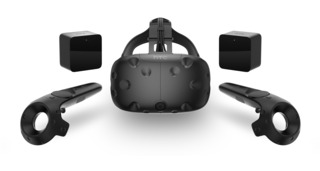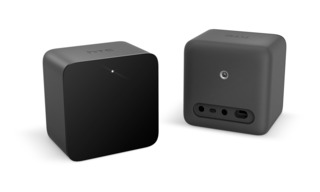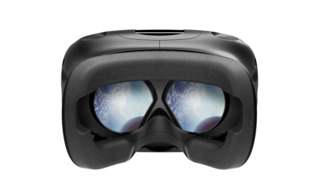Update: Click here to check out our impressions of the HTC Vive Deluxe Audio Strap.
Hot on the heels of Oculus Rift--the first major virtual reality headset to arrive in 2016--HTC and Valve have just upped the ante with Vive. It's more expensive at $800 compared to Rift's $600, but for good reason: Vive comes with a pair of custom-designed SteamVR controllers and two base stations that allow software to track your movement over a maximum area of 15 square feet.
Being able to walk around in virtual worlds with even a small amount of freedom undeniably enhances your sense of presence in that digital space, and the same can be said of playing in VR with a pair of Vive's one-handed motion-sensing controllers. They have a touchpad for your thumb, a trigger for your index finger, and buttons that activate when you tighten your grip, allowing you to simulate the feeling of grasping objects in VR. Playing Job Simulator 2050 in Vive, I was plugging in virtual computer cables, using a copy machine, and filing papers away with zero instructions or difficulties. I also intuitively knew how to swing my virtual bat in Homerun Derby, and how to use one controller as a palette and the other as a paint brush in the 3D painting app, Tilt Brush.
Vive's controllers are a big step up from traditional gamepads when it comes to playing in VR, and because their location is tracked in the same manner as the headset, you can see virtual representations of both controllers while wearing Vive, making them easier to manage without disrupting the experience should you have to put one down or pick one up. Oddly, while you can check a controller's battery life while wearing Vive, you can't do so by just looking at them in the real world. It's a small, forgivable oversight, but one that could nonetheless prove consistently annoying over time.
Vive's strongest selling point is how it marries freedom of movement and intuitive controls with a capable headset, but these premium features come with considerable requirements. To experience what it's like to walk around in VR with Vive, you need a minimum unobstructed area of 6.5' x 5', and a way to provide power to both base stations, which are intended to be mounted at a minimum height of 6.5' and no more than 15.5' apart.
Vive's strongest selling point is how it marries freedom of movement and intuitive controls with a capable headset
You can play some Vive experiences without setting up the base stations, but you'll be relegated to standing or sitting with a minimal amount of freedom to move around. Make no mistake: as Oculus Rift proved, there are still great VR experiences to be had from a stationary position. However, while Vive's controllers are valuable and a factor in the higher cost of Vive, the ability to partake in room-scale experiences is an equally-important selling point, and one that will prove difficult to implement for some users.
Vive is a high-end VR headset that requires a considerably powerful PC. Its minimum hardware requirements are similar to those of Oculus Rift, but it's a little more forgiving when it comes to the amount of required RAM. That said, there may be more to consider when budgeting for Vive if you don't already have a strong PC.

HTC Vive Minimum Requirements
- Graphics Card: GeForce GTX 970 or AMD Radeon R9 290 or better
- CPU: Intel Core i5 4590 or AMD FX 8350
- RAM: 4GB
- Video port: HDMI 1.4 or Display Port 1.2
- USB port: 1 USB 2.0 port
- Operating system: Windows 7 SP1 or newer
Considering Vive's advanced capabilities, these recommended specs are reasonable, but there's no getting around the fact that you still have to accommodate Vive's spatial requirements to get the most out of it. I had to move multiple pieces of furniture and rig extension cords to get it up and running as intended with enough free space to move around. The expectation is that you will drill holes into your walls to make the base stations permanent installations, but you may need to get creative if that isn't something you're comfortable with or capable of doing; tripod mounts are the suggested alternative, and strong, double-sided adhesive strips are also a viable if only temporary solution.
The physical setup procedure a bit complicated, but the tutorial in SteamVR guides you through the process step-by-step and confirms that everything is working as intended. This involves mounting the base stations, connecting Vive to your PC, and mapping out your play area, which involves using a Vive controller to physically trace the perimeter of your space.
Even if you have a space that's technically large enough for roomscale experiences, you may still have to bend over backwards to get it working.
As I found out, this process, while easy to execute in theory, is very unforgiving unless you have a lot of free space. I was in an area that was just big enough to support room-scale experiences, but the outline of the SteamVR's projection ever so slightly overlapped with my tracing during setup. Because SteamVR detected that the virtual projection it created based on my outline didn't fit its requirements, I had to repeat this step numerous times before it accepted that I had enough room to move around--it was a difference of inches. The lesson? Even if you have a space that's technically large enough for roomscale experiences, you may still have to bend over backwards to get it working. That said, in a room at GameSpot's office that more than meets the minimum space requirements, mapping the room was a simple, one-shot affair.

Once you have everything up and running, SteamVR walks you through a demo that teaches you the ins and outs of the controller and introduces you to the “chaperone,” SteamVR's term for the virtual walls it projects into VR when you get close to the real-world boundary of your VR space. This is a necessary evil when you're enveloped in VR but blind to the real world around you. The chaperone feature makes sure that you don't inadvertently run or walk into walls, a task it accomplishes effectively. But if you are working with the minimum amount of space--6.5' x 5'--prepare to see wireframe boundaries appear frequently as you move about.
No matter how you choose to use Vive, the headset is the most critical part of the experience. Vive is heavier at 550 grams compared to Rift's 470 grams, and a lot of this weight is felt up front, with the chassis placing noticeable pressure on your face. Vive's bundle of four cables seem noticeably obtrusive when you're stationary, but even more so when moving around a room. They run along the headset's top strap, fall down your back, and are a constant reminder that you're hooked up to a contraption. Vive's cables proved to be a regular hinderance when walking and turning in VR, and though I got better at blindly managing them the more I used Vive, I would still stumble over them on occasion.
Vive's head straps are quite floppy, and collapse under the weight of the cables when you try to quickly slip the headset on. These straps are also wide, so I was never able to find a fit where the side straps didn't overlap or dig into my ear. Vive can't match Rift when it comes to comfort, and when you consider that Rift has built-in, easily adjustable headphones, it's hands-down the more user-friendly of the two.
I found Vive's display to be adequate, though not impressive.
From a technical standpoint, the displays in Rift and Vive are practically identical. They both have a refresh rate of 90Hz and offer a resolution of 1080x1200 for each eye. As with Rift, I found Vive's display to be adequate, though not impressive. For the first few minutes of a session in VR, the pixels stand out, though this fades quickly as you begin to play and focus on the virtual world around you. That, more than your awareness of pixels, is the key takeaway. The low latency and high refresh rate of the display allow you to experience VR without the threat of simulation sickness due to hardware deficiencies--though some games that play with balance and orientation in extreme ways can still trigger a feeling of imbalance, regardless of your VR headset's capabilities.

SteamVR drives Vive, but it is a facet of Steam, the well-known PC gaming distribution platform. As such, when you're navigating virtual menus, you're presented with a very Steam-like series of menus and icons as you sort through your library of content. You navigate Steam VR using the controllers as you would a laser pointer, more or less: aim the laser from your virtual controller at an item on screen and pull the trigger to select it.
Your user interface in VR is for more than picking what games to play: you can also swap your view to interact with Steam proper, or to navigate your PC's desktop. The latter is a most appreciated feature that essentially gives you a massive computer monitor on which to browse files, navigate the internet, or really anything else you would do on a PC. The fact that you can control your desktop without removing your headset is invaluable.
Of course, if you're considering Vive in the first place, it's because you want to play games in VR, first and foremost. There are a lot of games available for Vive at launch--almost too many, considering how many are small, canned experiences that begin and end with you performing a simple task. While it's fun to swing a tennis racket and go virtual skeet shooting in VR with Vive due in large part to the freedom and interactivity afforded by its controllers and 360 degree motion tracking, far too many of the games feel like glorified tech demos with limited appeal.
Tombwater - Playable Demo Reveal Trailer The Elder Scrolls IV: Oblivion Remastered - Official Full Reveal Presentation Monster Hunter Wilds – Festival of Accord: Blossomdance | Spring Seasonal Event Trailer DRAGON BALL: Sparking! ZERO - DAIMA Character Pack 1 Gameplay Trailer Diablo 4 x Berserk | Official Full Animated Reveal Trailer Zenless Zone Zero - Vivian Character Demo | "Love Like a Bouquet" Capcom Fighting Collection 2 - Power Stone 2 and Capcom Fighting Evolution | Game Spotlight Trailer FATAL FURY: City of the Wolves|Official Play Guide Trailer Fortnite Galactic Battle Teaser Trailer DOOM: The Dark Ages | Official Gameplay Trailer 2 | Available May 15, 2025 The Oblivion Remaster Needs To Be Bad In Order To Be Good Zenless Zone Zero - Vivian Character Teaser | "When Birds Sing"
Please enter your date of birth to view this video
By clicking 'enter', you agree to GameSpot's
Terms of Use and Privacy Policy
Some games straddle the line, however, such as Job Simulator 2050. Here, you work in a comically depressing office space run by robots--among a handful of other work-related scenarios--who order you to perform menial tasks. It sounds dreadful, but it's actually quite enjoyable, thanks to good writing and a large variety of objects to interact with. It's not the sort of game you'd be desperate to play outside of VR, but Vive embeds you in the experience in a way that reshapes your connection to the virtual world.
That statement applies across the board when referring to Vive's roomscale-supported games; while the quality of the games varies greatly, they all inherently deliver an impressive experience by allowing you to walk around and, by treating your controllers as extensions of your hands, to interact with objects. For the moment, Vive offers the most feature-rich VR experience there is. If you list the features it has compared to Rift, there will only be a few differences, but Vive's few advantages make a big difference in practice. To go with Rift is to wade in the waters of VR; choosing Vive is like jumping into the deep end.
To go with Rift is to wade in the waters of VR; choosing Vive is like jumping into the deep end.
Before you take the plunge with Vive, you have to prepare yourself accordingly. Unlike Rift, Vive comes with strict spatial requirements if you plan to utilize its hardware's full potential. It's not the easiest suite of hardware to set up, nor is it as refined as Rift, but Vive delivers the most advanced VR experience to date, a luxury that comes at a cost and with compromises. Where Rift feel's like a VR headset built for mainstream consumption, Vive caters to the hardcore crowd that will stop at nothing to get the best VR experience. Over time, Oculus can presumably catch up when it releases its Touch controllers and sells individual sensors to expand Rift's interactivity and motion-tracking capabilities. But for people who can't wait, who are willing to go the extra mile right now, Vive is the only way to experience today's most advanced VR technology from the comfort of home.
